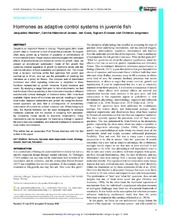| dc.contributor.author | Weidner, Jacqueline | |
| dc.contributor.author | Jensen, Camilla Håkonsrud | |
| dc.contributor.author | Giske, Jarl | |
| dc.contributor.author | Eliassen, Sigrunn | |
| dc.contributor.author | Jørgensen, Christian | |
| dc.date.accessioned | 2020-04-15T11:52:30Z | |
| dc.date.available | 2020-04-15T11:52:30Z | |
| dc.date.issued | 2020-02-17 | |
| dc.identifier.issn | 2046-6390 | en_US |
| dc.identifier.uri | http://hdl.handle.net/1956/21869 | |
| dc.description.abstract | Growth is an important theme in biology. Physiologists often relate growth rates to hormonal control of essential processes. Ecologists often study growth as a function of gradients or combinations of environmental factors. Fewer studies have investigated the combined effects of environmental and hormonal control on growth. Here, we present an evolutionary optimization model of fish growth that combines internal regulation of growth by hormone levels with the external influence of food availability and predation risk. The model finds a dynamic hormone profile that optimizes fish growth and survival up to 30 cm, and we use the probability of reaching this milestone as a proxy for fitness. The complex web of interrelated hormones and other signalling molecules is simplified to three functions represented by growth hormone, thyroid hormone and orexin. By studying a range from poor to rich environments, we find that the level of food availability in the environment results in different evolutionarily optimal strategies of hormone levels. With more food available, higher levels of hormones are optimal, resulting in higher food intake, standard metabolism and growth. By using this fitness-based approach we also find a consequence of evolutionary optimization of survival on optimal hormone use. Where foraging is risky, the thyroid hormone can be used strategically to increase metabolic potential and the chance of escaping from predators. By comparing model results to empirical observations, many mechanisms can be recognized, for instance a change in pace-of-life due to resource availability, and reduced emphasis on reserves in more stable environments. | en_US |
| dc.language.iso | eng | eng |
| dc.publisher | The Company of Biologists | en_US |
| dc.rights | Attribution CC BY | eng |
| dc.rights.uri | http://creativecommons.org/licenses/by/4.0/ | eng |
| dc.title | Hormones as adaptive control systems in juvenile fish | en_US |
| dc.type | Peer reviewed | |
| dc.type | Journal article | |
| dc.description.version | publishedVersion | en_US |
| dc.rights.holder | Copyright 2020. Published by The Company of Biologists Ltd | en_US |
| dc.source.articlenumber | bio046144 | |
| dc.identifier.doi | https://doi.org/10.1242/bio.046144 | |
| dc.identifier.cristin | 1843841 | |
| dc.source.journal | Biology Open | |
| dc.identifier.citation | Biology Open. 2020, 9 (2), bio046144. | |
| dc.source.volume | 9 | |
| dc.source.issue | 2 | |

